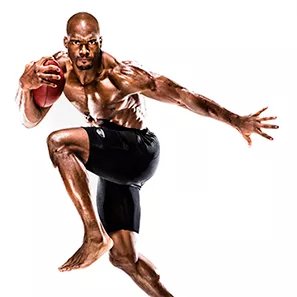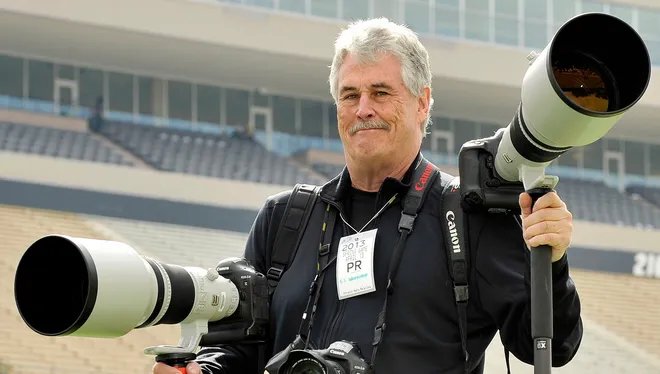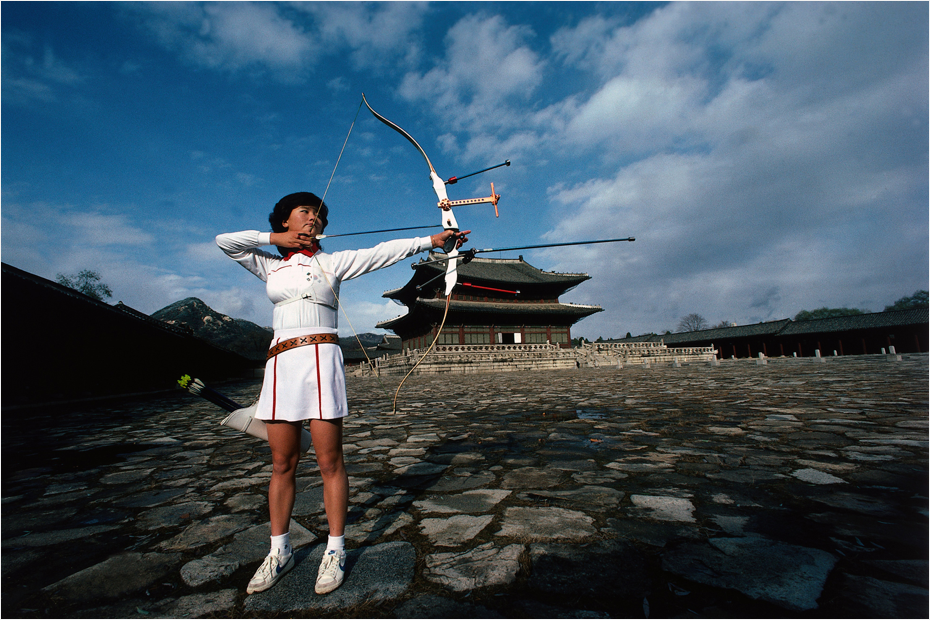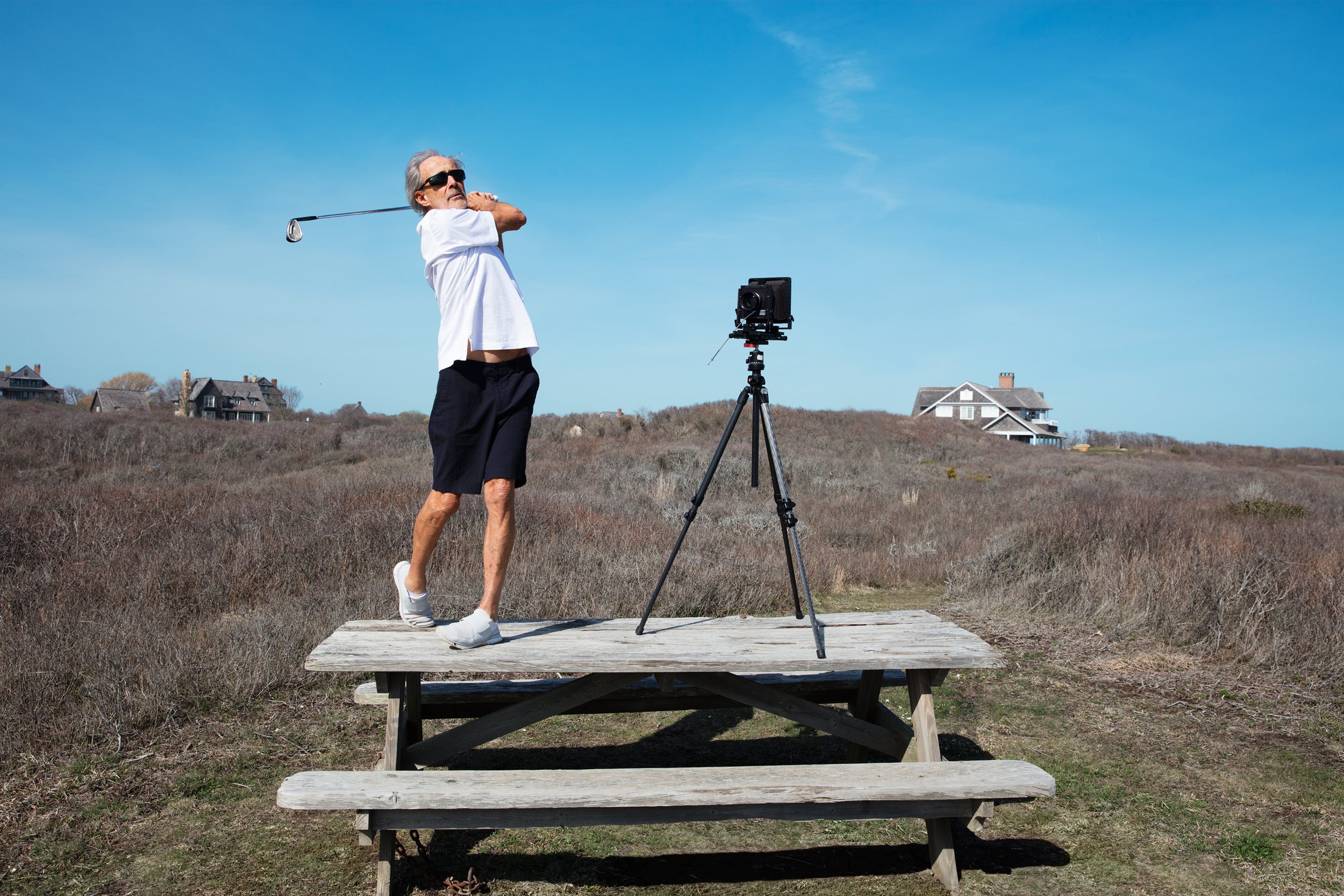Simon Bruty
"It's all about the moment. If you can capture the emotion, the atmosphere, and the energy, that's what makes a great sports photograph."
Simon Bruty is an award-winning sports photographer who has built a stellar reputation for his ability to capture the raw emotion, energy, and drama of sports events around the world. With a career spanning over three decades, Bruty's portfolio includes a vast array of iconic sports moments, from the adrenaline-fueled action of the Olympics to the fierce competition of the Premier League. Through his unique perspective and technical mastery, Bruty has established himself as one of the most influential sports photographers of his generation.
Early Life and Career
Born in London, Simon Bruty's passion for photography began at a young age. After completing his education, he secured a job at the Allsport agency (now part of Getty Images) in the late 1980s. This opportunity provided Bruty with the platform to develop his skills as a sports photographer and quickly led to assignments covering major sporting events worldwide.
Over the years, Bruty has worked as a staff photographer for Sports Illustrated, capturing some of the most iconic moments in sports history. His work has also been featured in numerous other publications, including ESPN, The New York Times, and The Guardian.
Photographic Style and Techniques
Simon Bruty is known for his ability to convey the emotion and intensity of sports through his images. His photographic style is characterized by a keen eye for detail, strong compositional skills, and the use of dramatic lighting. Bruty often employs a mix of wide-angle and telephoto lenses to capture the action, giving viewers a sense of the atmosphere and emotion of the moment.
One of Bruty's signature techniques is his use of remote cameras. By placing cameras in strategic locations around the playing field, Bruty can capture unique angles and perspectives that would be impossible to achieve from a single vantage point. This approach has resulted in some of his most memorable images, showcasing the athleticism and determination of the world's top athletes.
Career Highlights
Throughout his illustrious career, Simon Bruty has covered a wide range of sports events, including multiple Olympic Games, FIFA World Cups, and Wimbledon Championships. His iconic images have earned him numerous accolades, such as the prestigious World Press Photo Award and multiple awards from Pictures of the Year International.
Among Bruty's most notable assignments are his coverage of the 2012 London Olympics and his powerful images of the 1995 Rugby World Cup, where he captured the historic moment when Nelson Mandela presented the trophy to South Africa's captain, Francois Pienaar.
Photography Gear
Some of the gear that Simon Bruty has used throughout his career includes:
Canon DSLR cameras, such as the Canon EOS-1D X Mark II
A range of Canon lenses, including the EF 16-35mm f/2.8L, EF 70-200mm f/2.8L, and EF 400mm f/2.8L
Remote camera triggers and wireless transmitters
Monopods and tripods for stability during shoots
Published Works
While Simon Bruty has yet to publish a dedicated photo book of his work, his images have been featured in numerous publications and books, such as:
"Sports Illustrated Magazine (January 28, 2019 - February 4, 2019) Cloud Nine: Tom Brady and Bill Belichick Reach Their 9th Super Bowl" This issue of Sports Illustrated features the incredible photography of Simon Bruty, capturing the iconic duo of Tom Brady and Bill Belichick as they reach their 9th Super Bowl. Bruty's masterful eye for detail and ability to convey emotion through sports photography make this issue an excellent resource for photographers seeking inspiration in capturing the essence of competitive sports.
"Figure Skating: A True Book" This book presents Simon Bruty's unique perspective on figure skating, showcasing the elegance, beauty, and athleticism of this graceful sport. Bruty's photography captures the intensity and artistry of figure skating, providing inspiration and insights for photographers looking to improve their skills in capturing motion and emotion.
"Sports Illustrated (King of the Pool - The Amazing Michael Phelps, August 18, 2008)" This issue of Sports Illustrated highlights the remarkable achievements of Michael Phelps, with Simon Bruty's stunning photography capturing the essence of Phelps' incredible athletic prowess. Bruty's ability to document historic moments in sports through his lens makes this issue an invaluable resource for photographers aiming to learn from one of the best in the field.
Quotes
"It's all about the moment. If you can capture the emotion, the atmosphere, and the energy, that's what makes a great sports photograph."
"Sports photography is a constant challenge. There are always new techniques to learn, new angles to explore, and new stories to tell."
"I believe that a great sports photograph should be able to stand on its own, even without context. It should evoke a strong emotional response from the viewer."
"Being a sports photographer is not just about capturing the action; it's about telling a story and making a connection with the audience."
"In sports photography, timing is everything. Anticipating the moment and being in the right place at the right time can make all the difference."
Legacy and Influence
Simon Bruty's impressive body of work has left a lasting impact on the world of sports photography. His ability to capture the essence of sporting events and showcase the intensity of competition has inspired a new generation of photographers to follow in his footsteps. His innovative use of remote cameras and commitment to exploring new perspectives have pushed the boundaries of sports photography, setting a high standard for others to emulate.
Other notable sports photographers who share a similar style include Dave Black, Al Bello, and Robert Beck. These photographers, like Bruty, have made their mark by capturing the emotion, energy, and drama of sports events, leaving a lasting impact on the field of sports photography.
In conclusion, Simon Bruty's iconic images and commitment to innovation have made him one of the most influential sports photographers of his generation. His work serves as a testament to the power of photography to tell compelling stories and evoke strong emotions, ensuring his legacy will continue to inspire future generations of sports photographers.
Peter Read Miller
"Photography is a combination of technical knowledge and artistic vision. Never stop learning and refining your craft."
Peter Read Miller (website) is a renowned sports photographer whose work has been featured in some of the world's most prestigious sports publications, including Sports Illustrated, ESPN The Magazine, and Time. With a career spanning over four decades, Miller has documented some of the most iconic moments in sports history, capturing the energy, emotion, and drama that make sports so compelling.
Early Life and Career
Born in Pasadena, California, Peter Read Miller developed a passion for photography at an early age. He studied at the Art Center College of Design in Los Angeles before beginning his professional career as a photojournalist in the early 1970s. Miller's talent for capturing dynamic sports action quickly caught the attention of Sports Illustrated, where he began working as a staff photographer in 1983.
Photographic Style and Techniques
Miller's photographic style is characterized by his ability to freeze action and convey the intensity of a given moment in sports. His images often focus on the athletes' expressions and body language, highlighting their determination, passion, and drive. Miller's mastery of lighting and composition further elevates his images, creating visually striking photos that draw viewers in and engage them with the stories behind the scenes.
Peter Read Miller is also known for his innovative approach to sports photography. He is not afraid to experiment with new techniques, equipment, and perspectives, which allows him to produce unique and captivating images.
Career Highlights
Throughout his illustrious career, Peter Read Miller has covered a wide range of sporting events, including the Olympics, Super Bowls, World Series, and NBA Finals. His work has been featured on the cover of Sports Illustrated more than 100 times, and he has received numerous awards for his photography, including the Lucie Award for Achievement in Sports.
Miller's expertise and experience have also made him a sought-after educator and mentor within the photography community. He regularly conducts workshops and seminars, sharing his knowledge and passion for sports photography with aspiring photographers around the world.
Photography Gear
Peter Read Miller is known to use a variety of photography gear to capture the perfect shot. Some of the equipment he has used throughout his career includes:
Canon EOS 1D X Mark II and Canon EOS 5D Mark IV camera bodies
Canon EF lenses ranging from 16-35mm to 400mm
Gitzo tripods and monopods
PocketWizard remote triggers
Elinchrom lighting equipment
Photography Books
"Peter Read Miller on Sports Photography: A Sports Illustrated Photographer's Tips, Tricks, and Tales on Shooting Football, the Olympics, and Portraits of Athletes" This comprehensive book offers a unique opportunity to learn from one of the best in sports photography, Peter Read Miller. Readers will gain insights into his approach to capturing breathtaking moments in various sports, including football and the Olympics. With personal anecdotes and practical tips, this book serves as an invaluable resource for photographers looking to hone their skills and find inspiration in the dynamic world of sports photography.
Quotes
"I love the challenge of capturing the decisive moment in sports, whether it's the game-winning touchdown or the anguish of defeat."
"The best sports photographs are not just about the action; they're about the emotion and human drama that unfolds during competition."
"Photography is a combination of technical knowledge and artistic vision. Never stop learning and refining your craft."
"The key to great sports photography is anticipation. You have to know the sport well enough to be in the right place at the right time."
"Lighting is everything in photography. Whether it's natural or artificial, understanding how to use light effectively is essential for creating impactful images."
Legacy and Influence
Peter Read Miller's dynamic and engaging style has had a profound impact on the world of sports photography. His ability to capture the essence of a moment and tell a compelling story through his images has inspired countless photographers to pursue careers in sports photography. Miller's work has set a high standard for excellence and innovation in the field, pushing others to explore new techniques and push the boundaries of what is possible in sports photography.
Other notable sports photographers that share a similar style include John Biever, Walter Iooss, Al Bello, and Dave Black. These photographers, like Miller, have a keen eye for capturing the drama, emotion, and intensity of sports, creating powerful and memorable images that stand the test of time.
Miller's dedication to mentoring and educating others in the field has also left a lasting impact on the photography community. By sharing his knowledge and experience through workshops and seminars, he has helped shape the careers of many aspiring sports photographers and contributed to the continued growth and innovation in the world of sports photography.
In conclusion, Peter Read Miller's work has left an indelible mark on the world of sports photography. His keen eye for capturing the decisive moment, innovative techniques, and passion for the craft have influenced generations of photographers and set a high standard for excellence in the field. As a mentor and educator, Miller's legacy continues to inspire and shape the careers of many aspiring photographers, ensuring that the world of sports photography remains vibrant and ever-evolving.
Bob Martin
"Never be satisfied with your work. Always strive to improve and learn from every shoot."
Bob Martin (website) is a renowned sports photographer whose career has spanned over four decades. Known for his dynamic, action-packed images, Martin has captured some of the most iconic moments in sports history. His keen eye for composition, timing, and storytelling has earned him numerous awards and recognition within the photography community.
Early Life and Career
Bob Martin was born in the United Kingdom in 1959. His passion for photography began at a young age, and he started taking pictures of sports events at his school. After completing his education, Martin worked as a staff photographer for several newspapers before transitioning to freelance photography. In the early 1980s, he began specializing in sports photography and quickly gained a reputation for his exceptional work.
Photographic Style and Techniques
Martin's style is characterized by his ability to capture the intensity, emotion, and athleticism of sports competitions. He is known for his expert use of lighting, color, and composition, which allows him to create powerful and dramatic images. His attention to detail and strong sense of timing enable him to capture moments that tell a story, making his photographs engaging and memorable.
In addition to his technical prowess, Martin is also recognized for his ability to anticipate the action and position himself in the perfect spot to capture the decisive moment. This skill is especially critical in sports photography, where split-second timing can make all the difference between a great shot and a missed opportunity.
Career Highlights
Over the course of his illustrious career, Bob Martin has photographed a wide range of sports, including the Olympics, the World Cup, Wimbledon, and the Tour de France. Some of his most notable images include Usain Bolt's record-breaking runs, Serena Williams' powerful serves, and Michael Phelps' historic swimming achievements.
Martin's work has been featured in numerous publications such as Sports Illustrated, Time, and The New York Times. He has also received multiple awards, including the prestigious World Press Photo Award and the British Sports Photographer of the Year.
Photography Gear
Canon, Sony or Nikon DSLRs
Wide-angle and telephoto lenses
High-speed memory cards
Monopods and tripods for stability
Off-camera flashes and strobes for creative lighting
Photography Books
"1/1000th: The Sports Photography of Bob Martin" This remarkable book features a collection of Bob Martin's most iconic sports photographs, captured with precision and passion. Aspiring photographers will appreciate the valuable insights into his technique, as well as the fascinating stories behind each image.
"Wimbledon: Visions of the Championships" In this visually stunning book, Bob Martin offers readers an intimate and exclusive look at the world's most prestigious tennis tournament. Through his lens, one can appreciate the skill, emotion, and drama that unfolds on the courts of Wimbledon, making this a must-have for tennis enthusiasts and photographers alike.
"A Portrait of Wimbledon" This captivating book showcases Bob Martin's exceptional talent for capturing the essence of Wimbledon. From the intense battles on the court to the quieter moments behind the scenes, Martin's photographs reveal the spirit and charm of this iconic event. Readers will find inspiration in his ability to tell a story through each image, revealing the heart of Wimbledon.
Quotes
"In sports photography, timing is everything. You need to be in the right place at the right time and always be ready to capture the moment."
"The best sports photographs tell a story, capturing the emotion, energy, and intensity of competition."
"Never be satisfied with your work. Always strive to improve and learn from every shoot."
"Sports photography is about more than just action; it's about capturing the human side of athletes and the drama of competition."
"To be a successful sports photographer, you need to be passionate about the sports you cover and have a deep understanding of the athletes and their disciplines."
Legacy and Influence
Bob Martin's work has had a significant impact on the field of sports photography, inspiring both aspiring and established photographers to push the boundaries of their craft. His unique approach to capturing the drama and emotion of sports has influenced the work of other notable sports photographers such as Al Bello, John Biever, and Simon Bruty. His images have not only documented some of the most memorable moments in sports history but have also elevated sports photography to a fine art form.
Martin's dedication to his craft, relentless pursuit of improvement, and commitment to telling compelling stories through his images have set a high standard for sports photographers around the world. As a result, his work has not only been celebrated within the photography community but has also resonated with sports fans and the general public alike.
Bob Martin's impact on the field of sports photography extends beyond his own body of work. His success and dedication have paved the way for future generations of sports photographers, demonstrating that a career in sports photography is not only possible but can be highly rewarding and fulfilling.
Neil Leifer
"I've always believed that you can't be in the right place at the right time unless you're in the right place all the time."
Neil Leifer is a legendary sports photographer, renowned for his iconic images of some of the most memorable moments in sports history. His exceptional ability to capture the emotion and intensity of athletes in action has made him one of the most respected and influential photographers in the field. With a career spanning over six decades, Leifer has documented countless unforgettable moments and captured the essence of sports legends like Muhammad Ali, Joe Namath, and countless others.
Early Life and Career
Neil Leifer was born in New York City on December 28, 1942. His passion for photography began at an early age, and he started taking photos of sporting events when he was just 16 years old. In 1958, Leifer's talent was recognized when he won a contest for the best sports photograph of the year, which helped him gain a job as a staff photographer for Sports Illustrated.
Throughout his career, Leifer worked for numerous publications, including Time, Life, and People magazines, as well as the Saturday Evening Post. He has covered a wide range of sports, from boxing and football to baseball and horse racing. Some of his most memorable assignments include covering the Olympic Games and numerous Super Bowls.
Photographic Style and Techniques
Neil Leifer is known for his ability to capture the intensity and emotion of the athletes he photographs. His style is characterized by a keen eye for composition, timing, and the use of color and light to create dynamic and striking images. Leifer often uses unique angles and perspectives to tell a story through his images, setting him apart from other sports photographers.
Leifer's work is also known for its ability to portray the human side of athletes, often capturing intimate moments that reveal their personalities and emotions. This storytelling aspect of his photography has made his work not only visually appealing but also deeply engaging for the viewer.
Career Highlights
Throughout his illustrious career, Neil Leifer has captured some of the most iconic and memorable moments in sports history. Some of his most famous images include:
The famous shot of Muhammad Ali standing over a defeated Sonny Liston during their 1965 heavyweight title fight.
The image of Green Bay Packers coach Vince Lombardi being carried off the field after winning Super Bowl II in 1968.
The stunning shot of Secretariat winning the 1973 Belmont Stakes by 31 lengths, clinching the Triple Crown.
These images, among countless others, have solidified Leifer's reputation as one of the greatest sports photographers of all time.
Photography Gear
Throughout his career, Neil Leifer has used various types of photography equipment, including:
Nikon and Canon cameras
Wide-angle and telephoto lenses for capturing different perspectives
High-speed motor drives for continuous shooting during fast-paced action
Strobes and flash units for illuminating subjects and freezing motion
Photography Books
"Neil Leifer: Ballet in the Dirt: The Golden Age of Baseball" This captivating book showcases Neil Leifer's ability to capture the beauty and grace of baseball players in motion. Through his lens, readers will appreciate the elegance and artistry of America's favorite pastime, offering a unique perspective on the sport.
"Neil Leifer: Guts and Glory: the Golden Age of American Football 1958-1978" This book transports readers to the heart of American football during its golden age, with Leifer's powerful and evocative photography. The images provide an unparalleled look into the spirit and determination of the players, making it a must-read for sports enthusiasts and photographers alike.
"Relentless: The Stories behind the Photographs (Focus on American History Series)" In this revealing book, Leifer shares the stories and inspiration behind some of his most iconic photographs. Readers will gain a deeper understanding of his process, from planning to execution, as well as the historical context surrounding each image.
"The Best of Leifer" This collection presents the most memorable and impactful photographs from Neil Leifer's illustrious career. Aspiring photographers will find inspiration in the diverse range of subjects, masterful composition, and the powerful emotions captured in each image.
"Neil Leifer: Portraits" In this captivating book, Neil Leifer showcases his talent for capturing the essence of his subjects through portraiture. The collection features a diverse range of personalities, from athletes to celebrities, offering readers an intimate look at the photographer's skill and versatility.
Quotes
"I always try to tell a story with my pictures. You have to know the sport and the athletes to be able to anticipate the action."
"Lighting is everything. The difference between a good picture and a great picture often comes down to the way the light falls on your subject."
"I've always believed that you can't be in the right place at the right time unless you're in the right place all the time."
"The key to great sports photography is being able to anticipate the moment, and that requires a deep understanding of the sport and its players."
"Persistence and dedication are essential in sports photography. You have to be willing to put in the time and effort to get the shot you want."
Legacy and Influence
Neil Leifer's work has left an indelible mark on the world of sports photography. His iconic images have not only documented the history of sports but also provided inspiration for countless photographers who have followed in his footsteps. Leifer's unique approach to capturing the emotion, intensity, and human side of athletes has set a high standard for sports photography and continues to influence the work of contemporary photographers.
Other notable sports photographers who have a similar style to Leifer's work include Walter Iooss, John Biever, and Al Bello. These photographers, like Leifer, have made significant contributions to the field of sports photography, capturing the essence of athleticism and competition in their own unique ways.
In conclusion, Neil Leifer's six-decade career has cemented his status as one of the most influential and respected sports photographers in history. His images have captured the hearts and imaginations of sports fans around the world, and his legacy will undoubtedly continue to inspire future generations of photographers.
Walter Iooss Jr.
"In sports photography, you're really trying to capture a moment. It's the peak action or the defining moment of a game or an event."
Walter Iooss, an iconic sports photographer, has made a significant impact on the world of photography with his striking, dynamic images that capture the emotion and intensity of athletic competition. With a career spanning over five decades, Iooss has immortalized some of the most iconic moments in sports history, working with legends like Michael Jordan, Muhammad Ali, and Tiger Woods.
Early Life and Career
Walter Iooss was born on May 15, 1943, in Temple, Texas. He developed a passion for photography at a young age, receiving his first camera when he was just 14 years old. Iooss began his professional career in 1961, at the age of 17, when he landed a job as a staff photographer at Sports Illustrated. Over the years, he has contributed to more than 300 issues of the magazine, with his work gracing the cover numerous times.
Photographic Style and Techniques
Walter Iooss is known for his ability to capture the essence of sports, whether it's the intensity of a pivotal moment or the grace and fluidity of an athlete in motion. His keen eye for composition and timing, combined with his ability to form close relationships with the athletes he photographs, has enabled him to create intimate, powerful images that tell a story.
Iooss often utilizes dramatic lighting and bold colors to emphasize the action and emotion in his photographs. He is also known for his innovative techniques, such as mounting cameras on backboards, goalposts, or underwater, to provide unique perspectives and create dynamic, engaging images.
Career Highlights
Throughout his illustrious career, Walter Iooss has photographed some of the most iconic moments and figures in sports history. Some of his most memorable work includes:
His iconic portrait of Michael Jordan soaring through the air, which has become one of the most recognizable images in the world of sports.
His 1988 photograph of Muhammad Ali and Joe Frazier, showcasing their grace and agility as athletes.
Capturing the legendary 1998 home run chase between Mark McGwire and Sammy Sosa, which captivated the nation.
Photography Gear
Walter Iooss has used a variety of photography gear throughout his career, including:
Nikon and Canon DSLR cameras
Wide-angle and telephoto lenses, often using fast prime lenses for low-light conditions
Underwater housings for shooting in aquatic environments
Remote-controlled camera mounts for capturing unique perspectives
Photography Books
"Hoops: Four Decades of the Pro Game" takes readers on a visual journey through the history of professional basketball. This book features stunning photographs of iconic players, memorable moments, and behind-the-scenes action, revealing Iooss's incredible ability to capture the spirit and intensity of the game.
"Classic Baseball: The Photographs of Walter Iooss Jr." celebrates the timeless beauty of America's favorite pastime through the lens of one of its greatest photographers. With images spanning over four decades, this book offers a unique perspective on the sport, highlighting the passion, skill, and camaraderie that define it.
"Classic Golf: The Photographs of Walter Iooss Jr." brings to life the elegance and intensity of golf through a collection of breathtaking images. Iooss's keen eye for detail and composition shines through in this book, capturing the drama and grace of the sport and its legendary players.
"SHOOTING FOR THE GOLD: A Portrait of America's Olympic Athletes" presents a vivid collection of photographs featuring the dedication, talent, and spirit of America's Olympians. This book offers an intimate glimpse into the lives of these elite athletes, showcasing their commitment to excellence and their pursuit of Olympic glory.
Quotes
"In sports photography, you're really trying to capture a moment. It's the peak action or the defining moment of a game or an event."
"Photography is about relationships. It's about how you feel about somebody, how they feel about you, and how you interact."
"I think lighting is everything. When you're dealing with athletes and their bodies, you want to show off the definition and the muscles."
"The camera is an extension of yourself. You have to be in sync with the moment and the athlete to create the perfect image." 5. "The key to great sports photography is anticipation. You have to know the game and be able to predict where the action will be."
Legacy and Influence
Walter Iooss has left an indelible mark on the world of sports photography, inspiring countless photographers with his iconic images and innovative techniques. His passion, talent, and dedication to his craft have made him one of the most respected and influential photographers in the field. Other notable sports photographers who share a similar style with Iooss include Neil Leifer, Peter Read Miller, and Bob Martin.
Iooss's ability to capture the emotion, intensity, and beauty of sports has helped to elevate the genre, bringing a level of artistry and storytelling to the world of sports photography. His work has not only influenced fellow photographers but has also shaped the way we perceive and appreciate the world of sports. Through his exceptional body of work, Walter Iooss has secured his place as a true icon in the realm of sports photography.









































Today I want to talk about this particular picture — Muhammad Ali vs. Sonny Liston by Neil Leifer . I am going to take a closer at the story behind the photograph and why is this picture so iconic. So, let’s get started.